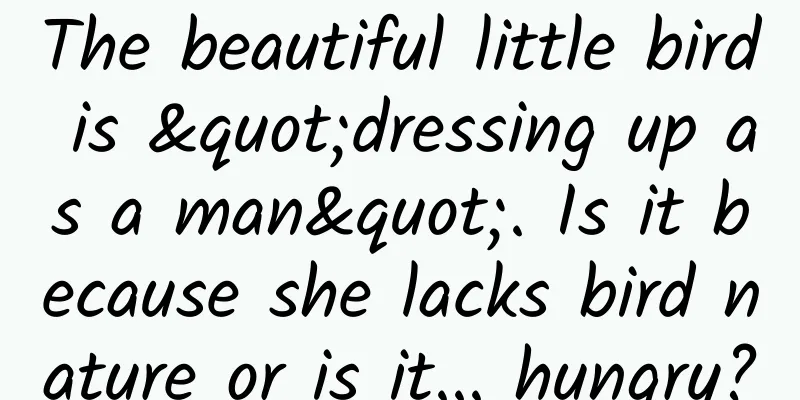The beautiful little bird is "dressing up as a man". Is it because she lacks bird nature or is it... hungry?

|
"The male rabbit's feet are confused, and the female rabbit's eyes are blurry. When two rabbits walk side by side, how can I tell which is male and which is female?" This poem must be familiar to everyone. In "The Ballad of Mulan", the author tells the story of Mulan disguising herself as a man and joining the army in place of her father. At the end, the author uses the metaphor of two rabbits running together, making it difficult to tell the difference between male and female, to answer the mystery of how Mulan hid the truth and fought on the battlefield. However, did you know that in nature, there is a kind of bird called white-necked hummingbird (Florisuga mellivora), some female individuals of which can actually "dress as men" like Mulan. Do they also have the important task of "defending territory"? Male white-necked hummingbird, doesn't it look gorgeous? Image source: Wikipedia 01 The Mulan of Hummingbirds In nature, there are obvious differences between male and female individuals of many birds, such as the familiar peacocks and mandarin ducks. This is called sex dimorphism , or sexual dimorphism, in biology. Generally speaking, among birds, males have more colorful feathers and a flashy appearance, while females look relatively ordinary and less noticeable. Male and female peacocks. Image source: veer gallery However, this "rule" is not absolute, at least not in some hummingbirds. There is a bird called the White-necked Hummingbird (Florisuga mellivora) that lives in Central and South America. Like most birds, the male and female White-necked Hummingbirds are very different in appearance. The male white-necked hummingbird has shimmering, brilliant sapphire feathers from head to neck. Not only that, the male's wings are also an iridescent blue-green, which contrasts sharply with their snow-white lower body and tail. Compared to males, most female white-necked hummingbirds look a bit ordinary, with "monotonous" olive green feathers all over their bodies. Female white-necked hummingbird (left) and male white-necked hummingbird (right). Image source: References Everyone must be asking, isn’t this sexual dimorphism? Don't be impatient, as mentioned before, most female white-necked hummingbirds are "ordinary-looking", but there are still some females who have learned to "dress as men" and do not look like their companions at all. In the 1950s, scientists discovered that some female white-necked hummingbirds looked like males. When they were sorting out specimens in a museum, they accidentally found that some specimens had female gonads but male appearance. But because the findings were only in specimens collected in museums, it's unclear whether the phenomenon is common in nature. Therefore, in recent years, some scientists have captured some white-necked hummingbirds in the wild to conduct relevant research. They tested the collected blood to distinguish the gender of these hummingbirds, and indeed got unexpected results. Some individuals that look like males are actually females. Specifically, scientists captured 436 white-necked hummingbirds in Gamboa, Panama between July 2015 and June 2019, including more than 120 female hummingbirds. Among these female hummingbirds, females "dressed as men" accounted for about 20% of the total! Why is this? 02 To avoid being disturbed, Female hummingbirds choose to dress as men Scientists have answered the common sexual dimorphism phenomenon in birds from many angles, among which the sexual selection hypothesis is the most accepted by the public. Simply put, male birds with good-looking appearance are more likely to be favored by the opposite sex, which can increase the success rate of mating. After all, females are a "scarce resource." Male mandarin ducks have more colorful feathers. Image source: veer photo gallery So why do female white-necked hummingbirds dress up as men? Could this help them stand out from their peers and win the favor of males? To answer these questions, scientists conducted a series of studies on hummingbirds. In the wild, male white-necked hummingbirds frequently chase females, and researchers installed electronic trackers on some hummingbirds (including some females that look like males) to understand whether "disguising as men" would increase the chances of females being chased by males. Through a large number of observations, scientists have found that the frequency of ordinary female birds being tracked by males is more than 10 times that of female birds "disguised as men"! That is, female birds don't make themselves look like males just to stand out from their peers. Could it be that the female bird does this to avoid being disturbed by her own kind? After discovering that female birds "dressing as men" is not the result of sexual selection, scientists turned their attention to resource competition. In nature, males are generally more "strong" and have more opportunities to obtain more resources, such as food. Therefore, they speculate that female birds look like male birds so that they will not be disturbed when eating. A common female white-necked hummingbird. Image source: Wikipedia To test the possibility of this explanation, the scientists set up 28 feeders and installed three types of fake white-necked hummingbirds on the feeders: a drab female, a showy female, and a male. They observed the interaction between hummingbirds that came to forage and these fake birds. The results showed that the hummingbirds that came to forage were not polite to these "kindred spirits" that occupied the feeders. They would hit or peck these fake birds, and ordinary females were attacked the most! Not only that, scientists have observed that ordinary females are more likely to be driven away from the feeder by other females than females with gorgeous appearance. In other words, for female white-necked hummingbirds, their colorful appearance can help them reduce harassment from their own kind and other hummingbirds. It is said that "food is the first necessity of the people", and this is no exception for female white-necked hummingbirds. 03 "A man's body, a woman's heart" Female hummingbirds only imitate appearance After answering the question of why female hummingbirds "dress as men", scientists have raised a new soul-searching question: Do female birds only imitate male birds in appearance, or do they also imitate male birds in behavior? Male white-necked hummingbirds have strong territorial behavior. They will drive other hummingbirds out of their territory to defend their sovereignty. Therefore, they are larger in size and have stronger flying ability and explosive power than females. After another experiment, scientists found that the females that looked like male birds only learned the appearance of male birds, but did not possess the males' flying ability and territorial behavior. Seeing this, we have a general understanding of the phenomenon of female white-necked hummingbirds imitating males: When they were still young birds, male and female white-necked hummingbirds had similar appearances, but as they grew up, the males grew into their own appearance, and 20% of the females chose to imitate the males, but this imitation only learned the appearance of the males and did not affect the behavioral characteristics of the females. This change would benefit female birds by giving them more food resources, but it would also reduce their chances of mating. Image source: References As for why 80% of female birds do not choose colorful feathers, but instead make themselves look ordinary, it is not difficult to understand. From the perspective of females, female birds generally have the responsibility of raising chicks, and a low-key appearance can reduce the possibility of them being discovered by natural enemies and increase their chances of survival. After all, colorful feathers are not only laborious to maintain, but also dangerous. Between eating and staying alive, female birds have their own choice. References: [1]Falk, JJ, Webster, MS, & Rubenstein, DR (2021). Male-like ornamentation in female hummingbirds results from social harassment rather than sexual selection. Current Biology, 31(19), 4381-4387. [2]Falk, JJ, Rubenstein, DR, Rico-Guevara, A., & Webster, MS (2022). Intersexual social dominance mimicry drives female hummingbird polymorphism. Proceedings of the Royal Society B, 289(1982), 20220332. [3]Diamant, ES, Falk, JJ, & Rubenstein, DR (2021). Male-like female morphs in hummingbirds: the evolution of a widespread sex-limited plumage polymorphism. Proceedings of the Royal Society B, 288(1945), 20203004. Produced by | Science Popularization China Author: EVEE (School of Life Sciences, Peking University) Producer|China Science Expo Submitted by: Computer Information Network Center, Chinese Academy of Sciences The cover image and the images in this article are from the copyright library Reproduction of image content is not authorized |
Recommend
What is the relationship between products, channels and shopping guide brands?
All customers will be involved in three major iss...
Brand Innovation Theory: Social Marketing
Although the ladder (model) of the "new comm...
How can the photography industry break through the market through Mayu advertising?
At present, the photography industry has develope...
Comment: American inventions plus Chinese manufacturing plus the global market are the future trend
The inventor in our impression is someone like Ed...
Anniversary event promotion example
Coinciding with the company's anniversary and...
Faraday Future is listed on Nasdaq, aiming to subvert Maybach, Jia Yueting: I must return to China
After years of dormancy overseas, Jia Yueting fin...
Oatmeal helps you lose weight and lower blood sugar? The premise is that you have to buy the right one
Because of its nutrition and health, oatmeal has ...
Cocos by Touch Technology won the title of National Cultural Industry Game Engine
Recently, Chukong Technology's cocos professi...
How to develop a financial accounting mini program and a financial diary mini program?
With the economic downturn, many people have begu...
Snakes in the Year of the Snake | A land of women among snakes? Like hot springs? These snakes actually have special skills
In the Late Jurassic more than 100 million years ...
Vitamins are important to us, but the more the better! How can we supplement them to be healthier?
In life, many people take vitamin tablets to supp...
36 Strategies of Sales Closing eBook
36 Strategies of Sales Closing eBook The first se...
Qt 5.4 released to help cross-platform application development and device creation
December 10, 2014 - The Qt Company today released...
How many resources can China Post mobilize through its cooperation with Alibaba?
Alibaba has added a new bargaining chip for its l...
"Micro-course Instructor Practical Training Camp" teaches at home, makes money sustainably, and earns over 10,000 yuan a month
Elites in various fields, hurry up and sort out y...









